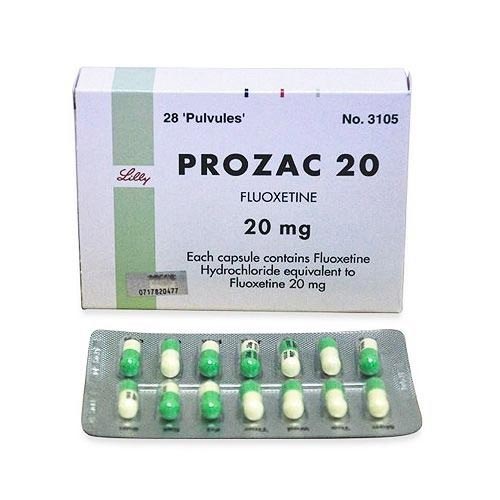Description
Fluoxetine may be used to treat major depressive disorder (MDD), moderate to severe bulimia nervosa, obsessive-compulsive disorder (OCD), premenstrual dysphoric disorder (PMDD), panic disorder with or without agoraphobia, and in combination with olanzapine for treatment-resistant or bipolar I depression. Fluoxetine is the most anorexic and stimulating SSRI.
Fluoxetine hydrochloride is the first agent of the class of antidepressants known as selective serotonin-reuptake inhibitors (SSRIs). Fluoxetine is a racemic mixture of the R- and S- enantiomers and are of equivalent pharmacologic activity. Despite distinct structural differences between compounds in this class, SSRIs possess similar pharmacological activity.
The overall clinical effect of increased mood and decreased anxiety is thought to be due to adaptive changes in neuronal function that leads to enhanced serotonergic neurotransmission.
Pharmacodynamics
Fluoxetine, an antidepressant agent belonging to the selective serotonin reuptake inhibitors (SSRIs), is used to treat depression, bulimia nervosa, premenstrual dysphoric disorder, panic disorder and post-traumatic stress.
According to the amines hypothesis, a functional decrease in the activity of amines, such as serotonin and norepinephrine, would result in depression; a functional increase of the activity of these amines would result in mood elevation. Fluoxetine’s effects are thought to be associated with the inhibition of 5HT receptor, which leads to an increase of serotonin level.
Antagonism of muscarinic, histaminergic, and α1–adrenergic receptors has been hypothesized to be associated with various anticholinergic, sedative, and cardiovascular effects of classical tricyclic antidepressant (TCA) drugs. Fluoxetine binds to these and other membrane receptors from brain tissue much less potently in vitro than do the tricyclic drugs.
Mechanism of action
Metabolized to norfluoxetine, fluoxetine is a selective serotonin-reuptake inhibitor (SSRI), it blocks the reuptake of serotonin at the serotonin reuptake pump of the neuronal membrane, enhancing the actions of serotonin on 5HT1A autoreceptors. SSRIs bind with significantly less affinity to histamine, acetylcholine, and norepinephrine receptors than tricyclic antidepressant drugs.
As with other antidepressant agents, several weeks of therapy may be required before a clinical effect is seen. SSRIs are potent inhibitors of neuronal serotonin reuptake. They have little to no effect on norepinephrine or dopamine reuptake and do not antagonize α- or β-adrenergic, dopamine D2 or histamine H1 receptors. During acute use, SSRIs block serotonin reuptake and increase serotonin stimulation of somatodendritic 5-HT1A and terminal autoreceptors. Chronic use leads to desensitization of somatodendritic 5-HT1A and terminal autoreceptors.
Side effects
All medicines may cause side effects, but many people have no, or minor, side effects.Some medical conditions may interact with Fluoxetine.
Tell your doctor or pharmacist if you have any medical conditions.
The most frequent side effects include: nervous system effects such as anxiety, nervousness, insomnia, drowsiness, fatigue or asthenia, tremor, and dizziness or lightheadedness; GI effects such as anorexia, nausea, and diarrhea; vasodilation; dry mouth; abnormal vision; decreased libido; abnormal ejaculation; rash; and sweating.
Withdrawal symptoms include flu-like symptoms, insomnia, nausea, imbalance, sensory changes and hyperactivity.
This is not a complete list of all side effects that may occur. If you have questions about side effects, contact your health care provider.



zoritoler imol –
I’m also commenting to let you understand what a remarkable experience my friend’s princess enjoyed checking your web page. She mastered too many pieces, most notably how it is like to have a very effective coaching style to make other individuals with ease master specified complex subject matter. You really did more than our own expectations. I appreciate you for coming up with these essential, dependable, informative and also fun thoughts on the topic to Lizeth.